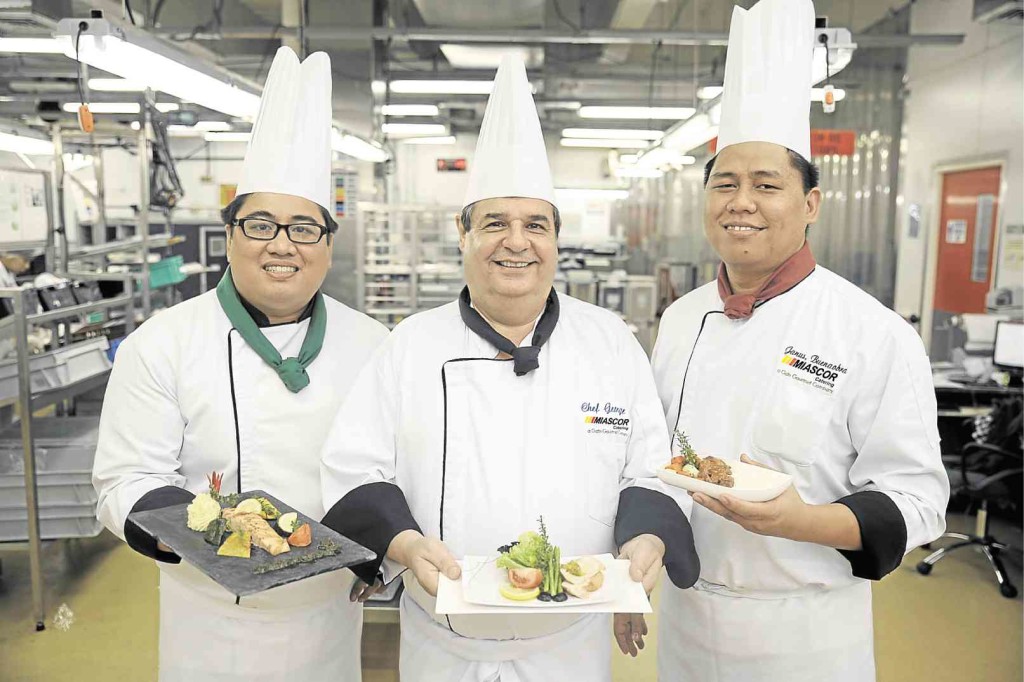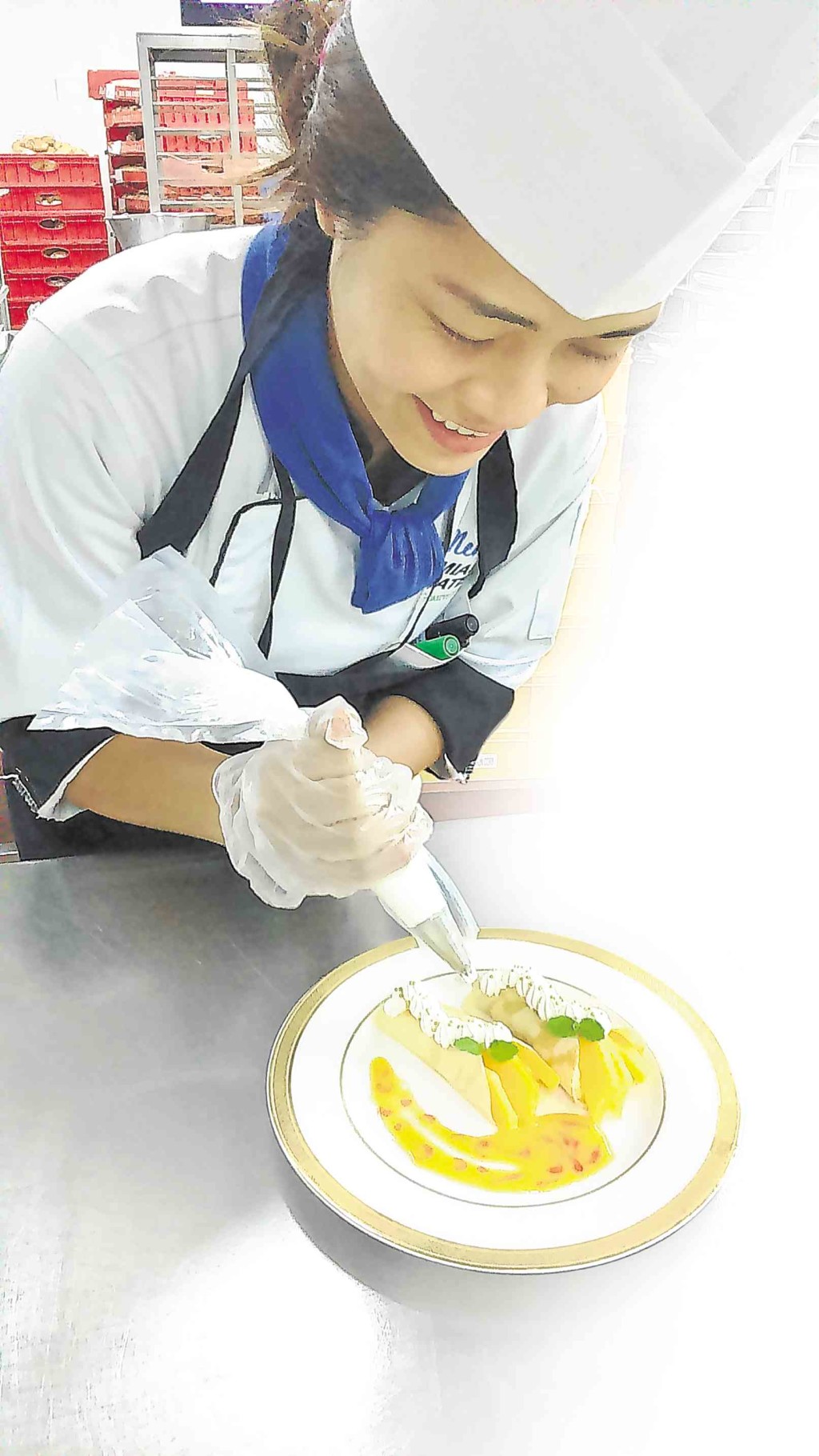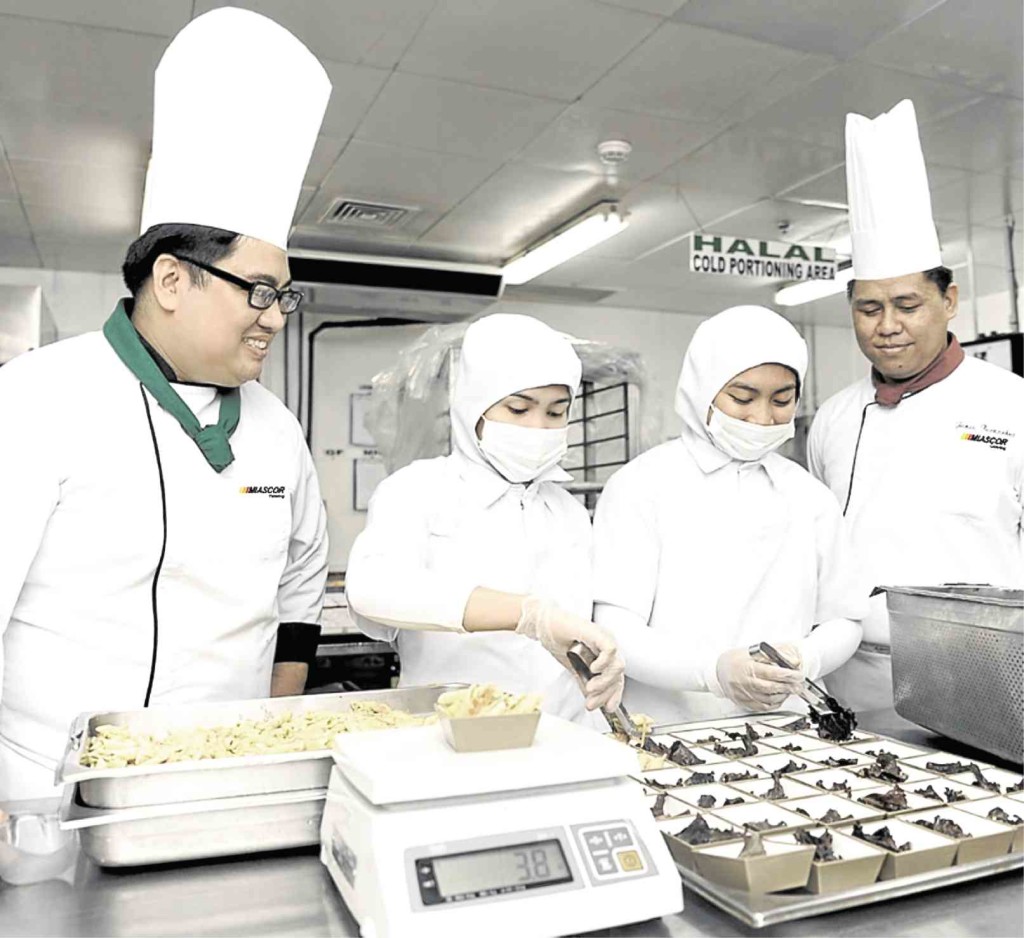Food for the skies

MIASCOR executive sous chef Mark Ledesma (left), executive chef and production manager Georges Egli and sous chef Janus Buenaobra
A hearty meal of adobo travels several hours in a maze-like assembly line before it is reheated and served during a flight.
Kitchen workers with face masks and lab gowns make sure the food is chilled to the right temperature and free from bacteria contamination before it gets anywhere near a passenger.
It is with this kind of military precision that Miascor Catering Services Corp.’s kitchen, found seven kilometers away from Terminal 1 of the Ninoy Aquino International Airport, makes its meals, to ensure that flyers properly get their gourmet fix up in the air.
Miascor’s 24-hour kitchen is fashioned like a factory—where meats are frozen in one room, vegetables are diced in one and endless boxes of supplies are stacked in another.
Knives and chopping boards are color-coded: Red for pork or beef, yellow for poultry and green for seafood.
“There are certain protocols that need to be followed,” says Miascor Catering general manager Rene Raemy.
He says food preparation for in-flight meals is fussier than the regular hotel food preparation since the caterer needs to be on double guard against contamination.
Inside one of the 11 degrees Celsius rooms of Miascor’s kitchen, bacteria-bait potatoes are soaked in a plastic container a few meters away from other ingredients.
Raemy, described by his colleagues as a food professional, says food quality and safety assurance are paramount in the airline catering business.
One has to be as meticulous as one can get.
Food handling
Raemy shares that some years back, a foreign carrier had to make an emergency landing four hours into the flight after people started getting sick.
It turned out salmonella was the culprit, no thanks to a kitchen worker who handled food with an open wound.
Food poisoning is also one of the reasons why pilots are usually given food packages separate from the batch served to passengers.
As much as possible, the problem has to be contained and the most important person in the flight protected.
Miascor Catering prides itself on undergoing methodical checks when it comes to the approximately 8,000 to 10,000 meals it sends out per day to flights leaving from the Naia and 4,000 meals from its kitchen near the Diosdado Macapagal International Airport in Clark.
Miascor Catering serves the likes of Malaysia Airlines, Cebu Pacific Air, Delta Airlines, KLM, Turkish Airlines, United and Thai Airways.
“We get all our fruits and vegetables locally. Some of the meats come from Australia. But one important thing to know is that whatever we get, our hygiene officers are there to audit,” says Raemy.
The 18-year-old Miascor Catering applies the Hazard Analysis Critical Control Points (HACCP) system followed by one of its parent firms, Gate Gourmet, where the Swiss-born Raemy came from.
The HACCP principles were created by Nasa to ensure astronauts are able to eat clean, safe food.
Miascor, which is managed by Miascor Aviation Group and Malaysia Airlines, is also audited by Canada-based Medina Quality Food Assurance Services.
Medina is a company of scientists and food service experts who audit a firm based on its ability to follow food safety standards.
“Either you pass or you don’t [Medina] … This is an extremely important part of our business. In a restaurant, you cook, serve and then eat it right there. What we do here: We cook, chill, transport, reheat before [food is] served. Some of the flights even take 12 hours. We don’t want anybody to get sick,” Raemy says.
Cebu Pacific director for inflight catering and sales JB Bueno, who is also a microbiologist, says it helps that there are several layers of monitoring in in-flight catering.
He takes note of the fact that the Bureau of Quarantine also visits the kitchens once every three months.
“They collect samples of the meals and do swab tests on the tables,” he says.
Altitude changes taste
But quality must not deter the firm from offering delicious, hearty meals. Twelve professional chefs work with Miascor Catering, overseeing 250 personnel doing the preparing and cooking in the firm’s two 24-hour kitchens.
These professionals must do precise science since the meals taste different while on land and while in the air.
It’s not that the flavors change.
“No, it’s the people who change. When you’re a mountain climber, remove your shoes while [at the peak] and wear them again later. Notice they are tighter,” says Raemy.
At a higher altitude, a person’s taste buds will also change.
“We try to explain to the airline that the food may be on the salty side [while on land] but people will then tell you it tastes bland [at high altitudes],” he says.
The process of freezing and reheating the food also makes it lose its moisture, thus a well-equipped kitchen plane with a respectable convection oven can also spell the difference when it comes to the taste.
Budget travel
These days, Miascor Catering is riding high on the trends followed by the aviation industry.
Low-cost carriers have begun competing with legacy carriers, albeit they’ve cut the usual offerings, like meals, to bring down their fares.
“The budget travel boom has helped us in a good way. Many of airlines’ [such as Cebu Pacific] customers are buying onboard or through online, so we’re producing those meals for them with their guidance,” says Citadel Holdings Inc. president Jose Ricardo Delgado.
Citadel owns the Miascor line of aviation services, including ground handling and catering.
“The difference is choice. You separately buy your ticket, your extra luggage, your meal. In legacy carriers, they only have one price,” says Cebu Pacific chief operations adviser Rick Howell.
Raemy says passengers indeed get “complimentary” food aboard legacy carriers, but pay more for their tickets and “end up getting something that they don’t want. With Cebu Pacific, you pay less for your ticket. And if you require a meal, you can buy and get what you actually want.”
Miascor Catering credits part of its success to Cebu Pacific in its 18 years of operation.
Delgado says tourism was doing poorly some seven to eight years ago and the caterer, despite its state-of-the-art kitchens, was averaging only 4,500 meals a day. The carriers also came in trickles at the Clark airport. “We were actually losing money every month just to keep it open,” he says.
But with carriers such as Cebu Pacific posting record financial gains and expanding their fleets, airline services have been riding on the boom.
Delgado says Miascor intends to put up more catering facilities where airports are, such as in Kalibo, Aklan, as well as in Guam, which is also now served by the Gokongwei-led airline.
The only barrier to expansion is the infrastructure problem besetting the industry, he says.
“I think the problem is that Naia is congested … We are really having a hard time coping with the growth. If we have an airport just like in Korea and Hong Kong, probably we can double the size of our kitchen,” he says.
Caterers are forced to “overstock” on the number of their meals.
Raemy jokingly says the “just-in-time” protocol that needs to be followed by airport services to eliminate wastage and overruns has become “just-never-in-time.”
Delgado hopes the new administration will be able to resolve the industry’s problems. “I’m hoping for a lot of consultation and interaction with the key players in the industry,” he says.
He says the entire industry—from catering to ground handling to the flights—has a vital role in the economy.
“The stakes in this industry have ramifications all over the country, whether you are a small exporter and you use air cargo to get your goods out to the United States in time for Christmas or whether you are a small hotel owner in Boracay and you’re counting on Cebu Pacific to bring in the people safely. So many lives are touched by this industry,” he says.






















